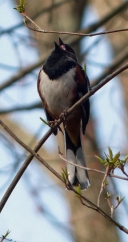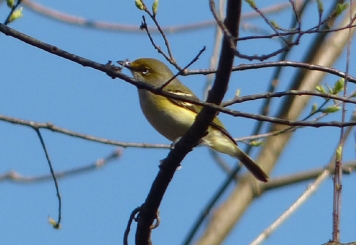
A Native American word meaning “old fields”, Hashawha is a Carroll County ebird hot spot. Hashawha Environmental Center is located in Northwestern Carroll County adjacent to the Union Mills Homestead five miles north of Westminster. The main

©Don Jewell
entrance is off of Route 97 North on John Owings Road. The Center offers hiking trails, fishing, and a nature center with a variety of programs throughout the year, a planetarium, and an outdoor school for county 6th graders. Parking is available at both the nature center and lake, while bathroom facilities are available only at the nature center. The park is open from dawn to dusk daily with no entrance fee. The Nature Center however is only open Wednesday through Sunday.
Birding can be productive at any time of year. The area has deciduous woodlands, fields, a small lake, raptor mews, and wetland areas. There are approximately five miles of trails, although not all are well marked, so a map may be necessary.
After turning on to John Owings Road from Route 97, roll down your windows and drive slowly. Many birds can be heard from the trees and shrubs next to the road. You will come to a pull-off on your left next to two small ponds. You can park and even begin hiking trails from this location as well. Screech and Great horned owl have both been found in the trees near this location. Yellow warblers drip from the trees around these two ponds in late spring and summer.
Common birds found in these trees and shrubs in warmer months are Red-winged blackbird, Blue gray gnatcatcher, Chipping, Swamp, and Song sparrows, Towhee, and American goldfinch. In the large field adjacent to the pond listen for Grasshopper and Field sparrows singing.

Check the two ponds to look for waterfowl, but most likely you will only see Canada geese and mallard. You can either begin hiking here or continue up the road. If you continue up the road, make sure to pause at the dip to listen over the large wetland area. You will hear swamp sparrow and may see a red-tailed hawk on a snag high over the wetland. We have also had Great horned owl at dusk here as well.
The road is busy at times, so you may want to pull over at the small pull-off area on the right of the road. It was on this small pull-off that I had my life Rose-breasted grosbeak many years ago. The wetlands and stream may also produce Belted kingfisher, American bittern and Great blue heron. In the spring, I enjoy driving slowly up along John Owings Road to listen for tanagers and warblers in the wooded neighborhood instead of turning directly in to the Center.

After turning left in the Center you can drive down to the lake area and park. There is a boardwalk around the lake that leads to the loop trail. In March the spring peepers at Hashawha are actually deafening. You have to cover your ears – the decibel level is so high! They are so numerous that you often see them hopping around the lake parking lot. In the area around the boardwalk in late spring and summer you can easily find Orchard and Baltimore orioles, Yellow warbler, Belted kingfisher, Eastern kingbird, Green heron, and Eastern phoebe. Catbirds abound as well. The lake area has a large congregation of Redwinged blackbirds. If you check the reeds along the lake you can usually spot a nest woven into the reeds. The lake is also excellent for summer butterfly and dragonfly hunting when the birding gets dull.

At the back of the lake there is a large sycamore tree with a bench underneath. I can almost guarantee orioles in that tree any year. You can usually see kingbirds, both orioles, Indigo bunting, and Yellow warblers in the trees around the back of the lake in the late spring and summer months.
Follow the trail behind the trees which will lead you down to a stream area. This area is very productive for migrating warblers in spring. I have had Black-throated blue, Black-throated green, Common yellowthroat, Palm, Northern parula, Yellow, Chestnut-sided, Wilson’s, Blue-winged, Ovenbird, Worm-eating, Prairie, Kentucky, Hooded, and Black and white warblers along this trail. You may also find Blue-gray gnatcatcher, Scarlet tanager, Baltimore oriole, Red and White-eyed vireos, Catbirds, Veery, Wood thrush, and both Waterthrushes. At any time of year listen and look for Barred owl in the wet woodlands along the trail. In spring and fall you may find both kinglets and possibly a Fox or Lincoln’s sparrow. The loop trail will take you through woods and fields and will eventually bring you back to the lake. Bird boxes along the trail are usually occupied by house wrens and in the winter by field mice. You will hear Acadian, Great-Crested and Willow flycatchers along the trail in warmer months. Some of the wooded ponds along the trail may also have wood duck.

The trail will wind by the outdoor school, raptor mews and behind the nature center. This is a good overview trail of the area. Many trails extend off of this main trail which extend out beyond Hashawha proper’s boundaries. We have had turkeys in the back parts of the trail, as well as off of the main road leading in to the center. Some of the more scrubby areas along the back trails may produce a chat in summer.
Make sure to check the feeders around the nature center at any time of year. Mostly you will see Tufted Titmouse, Carolina chickadee, Northern cardinal, American goldfinch and Whitebreasted nuthatch, however you may also see a migrant such as an Evening or Rose-breasted grosbeak. The hill in front of the nature center is filled with Tree swallows in spring and summer. They nest in the boxes around the area. Bluebirds are also very common. Hashawha has many woodpeckers. At any time of year you can find Downy, Hairy, Red-bellied, Pileated woodpeckers and Northern Flicker. In Fall and Winter you can find Yellow-bellied sapsuckers. In Winter at Hashawha you may find Golden-crowned kinglet, Hermit thrush, Winter wren, Yellow-bellied sapsucker and Black-capped chickadee.
At any time of year, Hashawha is a beautiful place to hike and enjoy the outdoors. Make sure Hashawha is on your list of Carroll County birding hot spots!
Tammy Schwaab, missingcw@aol.com
